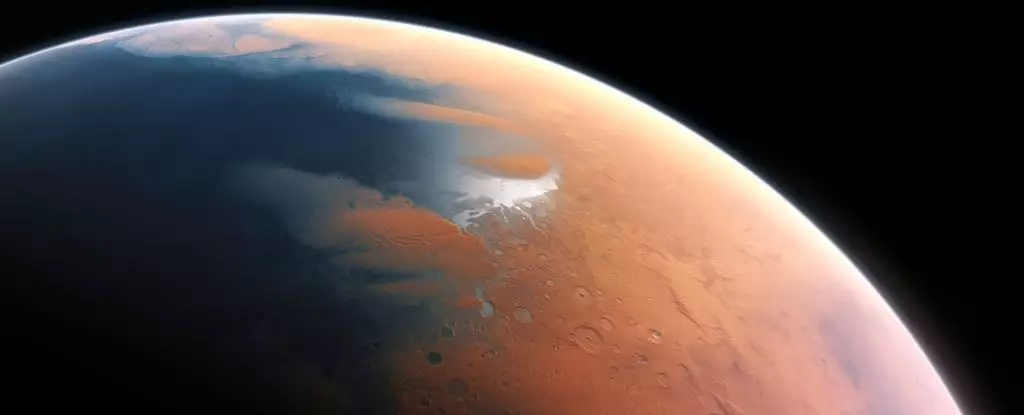In the realm of planetary exploration, few events have sparked as much excitement as the potential discovery of liquid water beneath Mars’ enigmatic surface. Recent findings suggest a concealed reservoir of water may lie deep within the Martian crust, offering profound implications for our understanding of the planet’s history and potential for life. Utilizing seismic data from NASA’s InSight mission, researchers have uncovered signs of liquid water at depths between 5.4 and 8 kilometers, redefining the traditional narrative of Mars as a cold, barren landscape.
The allure of Mars has captivated our imagination for generations, not only as a neighboring planet but as a possible cradle for life. Once upon a time, the Red Planet enjoyed a much warmer, wetter climate. This exciting new data fuels the ongoing discourse surrounding the evolution of Mars and the fate of its water, which has eluded scientists for decades. How did the water that once inundated the planet vanish, and what does this mean for future exploration? The seismic revelations may hold the key.
The Archaeology of Mars’ Water History
Mars is an open book revealing an ancient narrative filled with drying lakes and meandering rivers carved by flowing water during the Noachian and Hesperian periods, almost 4 billion years ago. However, as the magnetic field weakened and the atmosphere thinned, a large proportion of the planet’s surface water dissipated, presenting a compelling mystery: Where did it all go?
The current understanding suggests that some of the water escaped into space, while a portion became trapped in polar ice caps or minerals within the Martian crust. This narrative is reasonable but doesn’t account for all the “missing” water. Recent calculations propose the lost body of water could, in fact, cover the planet with an ocean ranging from 700 to 900 meters deep, prompting speculation that some may have seeped into the crust to remain hidden for epochs.
The findings align with longstanding hypotheses that associate Mars’ geologic past with meteorite impacts, which likely created extensive fractures capable of storing liquid water in the crust’s depths. Warmer conditions at such depths would allow water to persist, providing a reservoir potentially teeming with life or, at the very least, a crucial resource for future Martian expeditions.
Unveiling Martian Mysteries with Seismic Waves
The pivotal role of NASA’s InSight mission cannot be overstated. Deployed on Mars in 2018, InSight was equipped with a highly sensitive seismometer designed to listen closely to planetary seismicity. By analyzing shear waves—vibrations created from seismic activities such as meteorite impacts and marsquakes—researchers have made groundbreaking discoveries about the composition of the Martian crust.
This analysis revealed a low-velocity layer of material situated between 5.4 and 8 kilometers deep, likely indicative of a porous substrate brimming with liquid water. The concept aligns closely with Earth’s aquifers, wherein groundwater fills rock crevices, forming a saturated sponge-like layer. Remarkably, this subterranean reservoir could potentially house enough water to create a global ocean on Mars, dwarfing the amount contained in Earth’s Antarctic ice sheets.
Accurate mapping of these hidden water zones has become possible, thanks to seismic waves originating from recent meteorite strikes in 2021 and a notable marsquake in 2022. These seismic events acted like ripples in a pond, enabling scientists to construct a more intricate picture of Martian geology and potentially identify where water lies concealed beneath the surface.
Life and Exploration—Is There More Beneath the Surface?
The implications of this discovery reach beyond mere geological curiosity—the existence of liquid water opens the door to the possibility of ancient microbial life on Mars. On Earth, we find life in some of the most inhospitable conditions, including deep underground aquifers that are isolated from sunlight. If similar conditions existed on Mars, could remnants of its bygone ecosystems still be present in these water reservoirs?
Furthermore, the potential of this subterranean water reserve extends to future human exploration. For astronauts intending to establish a foothold on Mars, access to purified water could be life-saving, serving as a drinking supply, a source of oxygen, or even fuel for return missions. The existence of water would significantly enhance the viability of sustained human presence on the planet.
However, exploration comes with challenges. Drilling several kilometers beneath the Martian surface poses unprecedented hurdles that require innovative technologies. Data currently obtained only scratches the surface, as our seismic studies are limited to select regions. Future missions equipped with sophisticated tools will play a critical role in untangling the remaining secrets hidden beneath Martian soil.
The Ethical Obligation of Oceanic Discovery
As exploration pushes further, ethical questions arise regarding potential contamination of these pristine water zones. Just as Earth rigorously monitors ecosystems from invasive species, Mars exploration must tread carefully. Our missions should minimize risks to any native Martian biology that may exist in these zones. The quest for knowledge must not compromise potential forms of life that might still inhabit Mars.
The secrets that Mars holds beneath its cold exterior are more valuable than ever. Continuing to listen to its seismic heartbeat may unravel the mysteries of this once-vibrant planet and offer tantalizing insights into our own origins on Earth. With every breakthrough, we inch closer to understanding not just what Mars was, but also what it could become on a future timeline dominated by human exploration.

